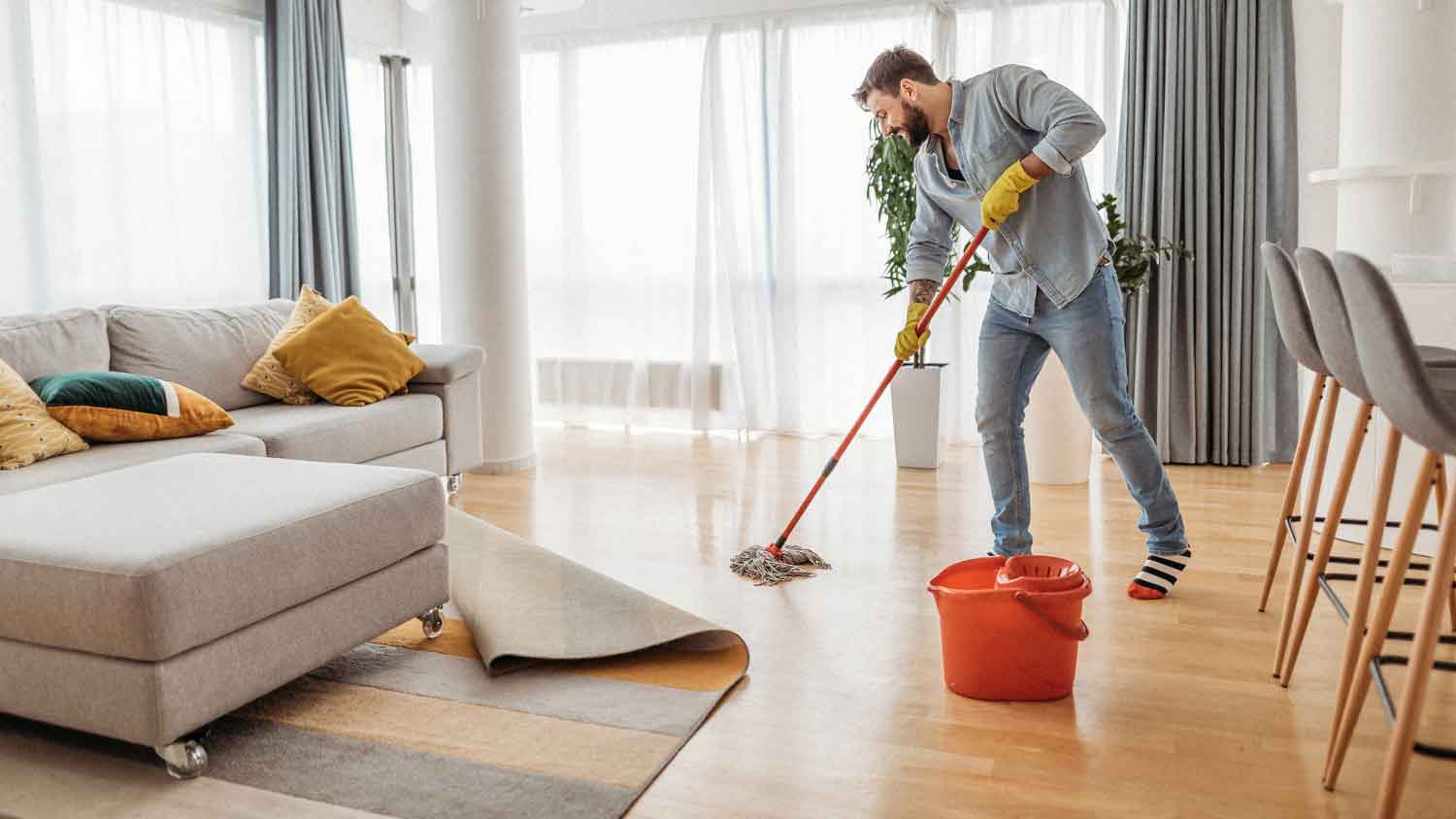The Step-by-Step Guide to Cleaning a Placemat
Preparing the perfect table includes keeping your placemats clean using these six steps


Whether you’re planning a formal dinner party or just hustling to get dinner on the table for the family, you might not think there’s much need to worry about the condition of your placemats when you’re trying to keep the kitchen clean as a whole.
But think again: Consider how many spills and stains your placemats collect at each meal. That can not only make for an unappealing and unsightly table, but it may also expose your family and guests to bacteria in your home.
How to Clean Placemats in 6 Easy Steps
Cleaning your placemats isn’t obsessive. It’s good hygiene. And it’s also not difficult. We’ll show you how to clean a placemat in six easy steps.
1. Inspect and Scrape Your Placemats
First, inspect your placemats for dried food particles. Use a butter knife to scrape off any easily removable leftovers that have dried on the mat. Use a soft and careful touch to avoid damaging the material.
2. Prepare for a Good Cleaning
Take two waterproof containers that are wide enough for soaking your placemats. Casserole dishes often work well for this. Fill up one container with hot water and add two tablespoons of liquid detergent. Fill up the other container with cold water.
3. Scrub Your Placemats
Once your hot and cold water soaks are ready, dip a soft-bristled brush into the hot, soapy water. Lightly brush away stains or food on your placemats by brushing in a circular motion.
For tough stains, soak the entire placemat in the hot water for a few minutes. Be careful, though, if your placemats have a coating, such as a plastic sheath. If the water is too hot or you soak the mats for too long in hot water, the coating may melt or the material may be damaged.
4. Soak Away
After you've scrubbed out your stains, place each placemat in the cold water for several minutes. This will rinse away the debris and the detergent.
5. Give the Placemats a Final Rinse
If you still have some debris residue or your placemats are still a bit soapy, rinse them in cool or cold water under your kitchen faucet. Gently ring cloth placemats under the running water.
6. Dry and Store Your Placemats
Once you’ve washed and thoroughly rinsed your placemats, hang them to dry on a hanging rack or clothesline, or place them on top of several paper towels. Make sure each placemat is allowed to dry completely to prevent the growth of mold and mildew.
After your mats have dried, store them in a cool, clean, and well-ventilated area to keep them pristine until the next use.
How to Clean Placemats by Type
Since you probably use different styles of placemats for different occasions, we’ve got you covered with the essential cleaning tips by material type.
Vinyl or Plastic
These are the most user-friendly and easiest to clean. Just scrape off food remnants with a butter knife and give them a good washing in warm soapy water.
Cloth
With cloth placemats, speed is key. If you have a spill, try to spot-clean immediately to prevent staining. Check the manufacturers’ instructions for your cloth placemats, as most can be laundered in the washing machine on a gentle cycle. The wash temperature will depend on the material type, however.
You may also be able to use bleach or a stain removal pre-wash treatment, depending on the color, material, and type of stain. In general, it’s best to let cloth placemats dry flat rather than placing them in the clothes dryer.
Bamboo
Bamboo placemats are becoming increasingly popular both for their durability and general loveliness. Bamboo placemats can’t be placed in the washer and dryer. Instead, a gentle hand-cleaning is best.
Here’s how to clean bamboo placemats:
Start by brushing off any debris or residue that might have gotten trapped between the strands.
Then, spray the mat with a mixture of 1 teaspoon of salt and 1 cup of lemon juice and vinegar.
Use a soft-bristled toothbrush to remove stubborn debris from the nooks and crannies of your placemat.
If you have resistant stains, try spot cleaning with rubbing alcohol and a damp cloth or sponge. But remember to pat, not rub, to avoid setting the stain or damaging the threads that hold the bamboo strands together.
If the alcohol doesn’t work, or you want to try something a bit milder, cleaning with a mild dish detergent and warm water may be all you need. But remember never to immerse your bamboo placemat in water, as this may damage it.
Once you’ve finished cleaning, pat your placemat dry with a clean cloth and lay it aside to finish air-drying. And if you want to go the extra mile, consider applying mineral oil or food-grade bamboo oil to freshen up your mat and protect it through all the lovely meals to come!
Jute
Jute is another increasingly popular material for placemats, especially due to its heat-resistant properties and happy, golden color. But the fibers can be brittle, so you will want to clean with care.
Here’s how to clean a jute placemat:
If you have a spill, try to tackle it as quickly as possible. Blot the spill firmly but gently with an absorbent cloth.
If the spill leaves a stain, then you will want to apply a mild detergent with a damp cloth or sponge only on the stain itself, using cold water.
You might also use a soft-bristle toothbrush or dull knife to gently scrape away any debris.
If your jute placemat has a red wine or tomato-based stain, apply club soda with a damp cloth to try to remove, or at least loosen, the stain.
Then, follow up with another cleaning using mild soap and a damp cloth or sponge.
To clean the entire placemat, use a damp cloth or sponge and very mild soap. Take care not to rub vigorously to avoid damaging the fibers.
After you finish, immediately use a hairdryer on a low setting to dry the placemat. Air-drying is not ideal for jute because it can damage the fiber or lead to mold and mildew.
A final word: Because jute can be a fragile fabric, treat it tenderly. Keep the placemat in the shade, as sunlight can fade and damage the fibers. And never wring or twist your placemat because that will wreak havoc on your brittle jute strands.
Bonus Placemat Cleaning Tip

When it comes to cleaning, not all placemats are created equally. While lace and linen may lend elegance to a table, they’re also far harder to clean than other materials like vinyl.
So save the cloth placemats for elegant occasions and choose easier-to-clean options for casual, everyday use that you can easily wipe down before washing. You’ll especially appreciate them if you have kids, as it makes after-dinner cleanup a breeze.





- When You Should Use Hot or Cold Water for Stains
- 17 Tips for Sparkling-Clean Appliances, From Dryers to Dishwashers
- 26 House Cleaning Tips to Elevate Your Cleaning Game
- Learn How to Clean Your House (and Maybe Even Have Fun Doing It) With These 27 Tips
- The Ultimate Room-by-Room Spring Cleaning Checklist
- Get Ready for Spring by Completing These Kitchen Cleaning Tasks
- How to Clean the Exterior of Your House Like a Pro
- These Are the Best Tools for Cleaning Hard-to-Reach Areas
- How to Clean Eggshell Paint Walls in 5 Easy Steps
- 14 Preventive Plumbing Maintenance Tips You Should Know








